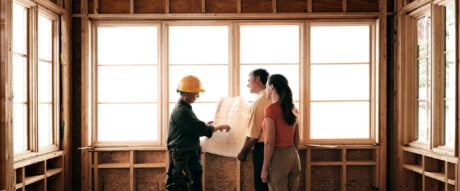The difference between your mortgage balance and your house’s market value is called equity. Paying down the principal of your mortgage builds equity, as do increases in market value over time.
Selling is one way homeowners can access equity; you sell your house for more than you owe and pocket the profit. To access that equity without selling, consider a home equity loan.
Home equity loan definition
Also commonly known in Canada as a second mortgage (or an add-on mortgage), a home equity loan is a loan taken out on a home that already has a primary mortgage.
The house itself acts as collateral for both the primary mortgage and any second mortgages, meaning failure to pay either could result in the loss of the property.
A homeowner might consider getting a home equity loan if they need access to a lump sum of cash, but don’t want to sell their house.
It’s typically recommended that home equity loans be reserved for expenses that may increase the overall value of the property, such as a kitchen renovation or adding on an additional bedroom. But it’s not uncommon for home equity loans to be used for other purposes, such as consolidating credit card debt or paying for a child’s post-secondary education.
How home equity loans work
As with a regular mortgage, you’ll need to apply and qualify for a home equity loan. Once you’re approved for the home equity loan amount you need, you’d be given a one-time lump sum with a fixed or variable rate of interest over a set term. You’d then be responsible for making regular payments on both your first and second mortgages simultaneously.
It’s worth noting that while home equity loan interest rates are typically lower than that of a credit card or most other kinds of loans, they’re often higher than first mortgage rates. That’s because lenders see second mortgages as riskier than first mortgages.
If you default on payments and your home is seized and sold, your original mortgage is paid off first, and the lender of the home equity loan get whatever is left. To offset the risk of not being repaid in full if you default on your loan, second mortgage providers charge higher interest rates.
Best Mortgage Rates in Canada
Compare Canada’s top mortgage lenders and brokers side-by-side and find out the best mortgage rates that will meet your need
Estimating your home equity
In Canada, home equity loans allow you to borrow 80% of your home’s market value, minus the balance of your primary mortgage.
Start by estimating how much your house is worth. You can do this by using online valuation tools, taking a look at similar houses that have recently sold in your area, or paying for a professional home appraisal. Once you have a ballpark figure, calculate 80% of that amount. Then you’ll subtract the remaining balance on your mortgage to figure out how much equity you have. Here’s an example:
Let’s say your home’s market value is $800,000 and you still owe $400,000 on your mortgage.
$800,000 x 0.80 = $640,000
$640,000 – $400,000 = $240,000
So the maximum amount you might be able borrow with a home equity loan would be $240,000.
Home equity loan vs. HELOC
Like a home equity loan, a home equity line of credit allows you to borrow money based on the built-up equity in your home. However, there are some big differences between these two second mortgage options.
With a HELOC, borrowing is limited to up to 65% of your home’s market value.
Furthermore, a HELOC doesn’t require you to decide the exact amount you need to borrow. Like credit cards, HELOCs are revolving lines of credit, which means you have a maximum borrowing limit, and can make withdrawals of various sums, as you need them. If you’re planning a series of home renovations that you’ll tackle over time, and aren’t quite sure what the total cost will be, a HELOC might make more sense than a home equity loan.
Unlike home equity loans, which are paid back through principal and interest payments, HELOCs may give you the option to make interest-only payments for a time. While this adds flexibility, it can also increase the length of time you carry the debt and how much you eventually pay back. Additionally, HELOCs usually feature variable rather than fixed rates, which means the cost of borrowing can rise unexpectedly.
» MORE: Fixed vs variable-rate mortgages
Pros and cons of a home equity loan
Pros
- Access up to 80% of your home’s equity in a lump sum payment.
- Lower interest rates than credit cards, unsecured personal loans or lines of credit,
- Fixed-rate home equity loans offer a predictable monthly payment and repayment schedule
Cons
- Not all major banks in Canada offer home equity loans.
- Higher interest rates than primary mortgages.
- Your home is the collateral, meaning you could be at risk of foreclosure if you have trouble repaying.
- Getting a home equity loan involves fees, like appraisal or legal fees.
Home equity loan alternatives to consider
A HELOC can be a good alternative to a second mortgage as long as you are disciplined about repayment and don’t borrow more than you need. Other alternatives to a home equity loan include:
Reverse mortgage
If you are 55 years of age or older, you may qualify for a reverse mortgage that will allow you to borrow up to 55% of your home’s equity. You don’t need to make any payments on the loan until you sell the property or die, in which case your estate would pay off the reverse mortgage. However, there may be fees involved and, because you aren’t required to make payments, it can be easy for interest to accumulate.
Cash-out refinance mortgage
A cash-out refinance is when you refinance your existing mortgage for more than what you currently owe on it. You then “cash out” the difference between your existing mortgage and your new amount owing. You can borrow up to 80% of your home’s appraised value minus the amount remaining on your original mortgage. While you may be able to lock in a low interest rate, you may pay penalties and fees (such as an appraisal fee) if you refinance a mortgage before the end of its term.
Blended mortgage
Another way to access your equity and get a lower mortgage rate is to get a blended mortgage. With a blended mortgage, you combine the rate from your existing mortgage with the rate from a new mortgage. The two rates are then blended into a single mortgage with a new rate that falls somewhere between the two.
Blending your mortgage may also help you avoid paying a prepayment penalty, since you’re not technically breaking your original mortgage contract. Note that with a blended mortgage, you can opt to extend your new mortgage term (blend-and-extend option) or end the mortgage contract when the original term was slated to end (blend-to-term option), though not all banks offer both options.

Best Mortgage Rates in Canada
Compare customized mortgage rates from Canada’s best lenders and brokers for free. Find and easily apply for the lowest mortgage rate for your needs.

The Greener Homes Grant and Other Money-Saving Programs for Homeowners
If you want to significantly impact your home’s energy consumption, it will likely require a little more than switching to LED lightbulbs or adjusting your thermostat. There are several federal, provincial and municipal incentive programs, including the Greener Homes Grant, that can help you manage the cost of making your home more energy efficient. Let’s […]



